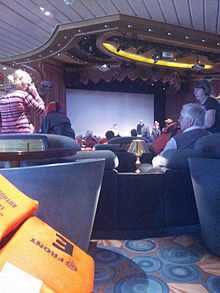Muster drill


A muster drill (also sometimes referred to as a lifeboat drill or a boat drill) is an exercise conducted by the crew of a ship prior to embarking on a voyage. The purpose of a muster drill is to prepare passengers for safe evacuation in the event of an emergency while on board the ship and to familiarize crew and passengers with escape routes. In a muster drill, passengers are educated on the use of life vests and escape routes from the ship.[1] It is typically conducted approximately 30 minutes prior to the ship's scheduled departure time and all guests must remain silent during the drill so that everyone will be able to hear the safety announcements from the captain. To alert that the drill is in progress, a general emergency alarm is sounded and after the signal, the captain explains what the passengers need to do.
Description
As required by the International Convention for the Safety of Life at Sea, a passenger muster drill must be conducted by the ship within 24 hours of departure,[2] but many cruise lines choose to conduct the drill before the ship departs port for the first time. It is the responsibility of the crew to ensure that a muster drill is held, and that every passenger and crew member is aware that it is being held. If a muster drill cannot be held, a report in the logbook must be made stating the circumstances.[3]
Laws in some places hold crew members liable to face civil charges if they voluntarily do not attend the muster drill. For example, in some U.S. states, those who do not attend are fined varying amounts, depending on their rank.[4][5]
Muster drills are typically not conducted and are usually not required on short trips on the water, such as those taken on ferries, dinner cruises, and riverboats. On ferries, a safety briefing delivered through the PA system alerts passengers to the sound pattern of the emergency alarm, and what to do if this alarm is heard.
Announcements

An announcement is normally made to passengers, informing them that a mandatory muster drill will begin shortly.
After this, another announcement is made, informing crew and passengers, that the "General Emergency Alarm" is about to be sounded, for exercise purposes only.
After the alarm has been sounded, passengers are told to then make their way to their Muster Station.
Alarm Signal
The "General Emergency Alarm" consists of seven or more short blasts followed by one long blast of the ship's horn or whistle (some lines don't sound the signal on the horn or whistle) and by the ship's internal alarm (such as fire alarm bells) accompanied with flashing strobe lights in corridors and public areas for hearing impaired) and PA systems with a tone.
Time
In the wake of the Costa Concordia disaster, all cruise ships are required to perform the muster drill before the ship leaves port. This change was made because a majority of passengers aboard the Concordia stated that they had not been through the drill and did not know where the lifeboats were located. Its length will vary depending on the size of the ship and co-operation of passengers. The time taken to get all passengers into lifeboats and to maneuver away from the ship is regulated by the International Maritime Organization, and must be accomplished in 30 minutes.[6]
See also
- Women and children first (protocol)
References
- ↑ Wallace, I.G. (1995). Developing Effective Safety Systems. Institution of Chemical Engineers. p. 135. ISBN 9780852953587. Retrieved 2014-10-04.
- ↑ MGN 71 retrieved from http://www.mcga.gov.uk/c4mca/mgn71.pdf
- ↑ International Maritime Organization (2001). Code for the Construction and Equipment of Mobile Offshore Drilling Units. International Maritime Organization. p. 134. ISBN 9789280151091. Retrieved 2014-10-04.
- ↑ Kentucky (1865). Acts Passed at the ... Session of the General Assembly for the Commonwealth of Kentucky. J. Bradford, printer to the Commonwealth. p. 111. Retrieved 2014-10-04.
- ↑ Ohio; Ohio. General Assembly; Ohio. Secretary of State (1864). Acts of the State of Ohio (v. 61). N. Willis, printer to the state. p. 118. Retrieved 2014-10-04.
- ↑ Tom de Castella (16 Jan 2012). "Costa Concordia: The Rules of Evacuating a Ship". BBC News.